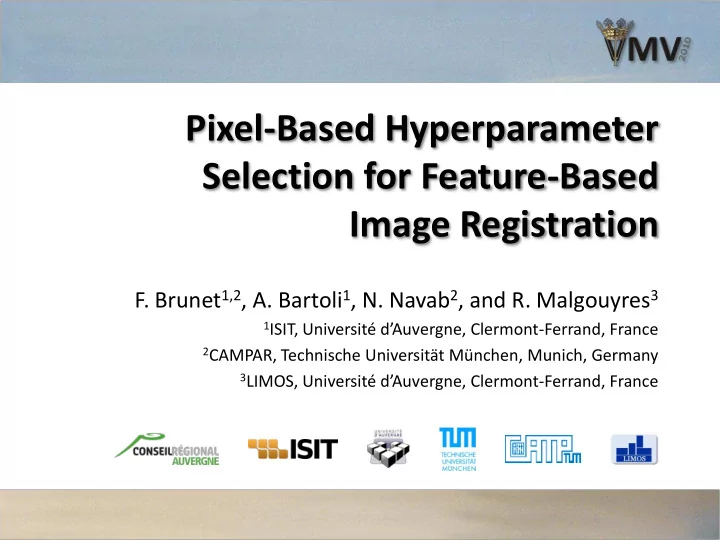

Pixel-Based Hyperparameter Selection for Feature-Based Image Registration F. Brunet 1,2 , A. Bartoli 1 , N. Navab 2 , and R. Malgouyres 3 1 ISIT, Université d’Auvergne, Clermont -Ferrand, France 2 CAMPAR, Technische Universität München, Munich, Germany 3 LIMOS, Université d’Auvergne, Clermont -Ferrand, France
Outline • What is image registration? – General principle – Standard approaches • Problem: choice of the hyperparameters • Our approach • Experimental results F. Brunet, A. Bartoli, R. Malgouyres, and N. Navab
What is image registration? Find the geometric transformation that aligns a source image and a target image ¯ nd p such that: W ( ¢ ; p ) Target image T Source image S F. Brunet, A. Bartoli, R. Malgouyres, and N. Navab
Two standard approaches • The feature-based approach • The direct approach (photometric approach) F. Brunet, A. Bartoli, R. Malgouyres, and N. Navab
The feature-based approach Source image S Target image T F. Brunet, A. Bartoli, R. Malgouyres, and N. Navab
The feature-based approach Extracting point correspondences f q i $ q 0 i g n i =1 q i q 0 i [ Methods : SIFT, SURF, … ] F. Brunet, A. Bartoli, R. Malgouyres, and N. Navab
The feature-based approach The parameters p * of the transformation are computed from the point correspondences n X p ¤ = arg min i k 2 kW ( q i ; p ) ¡ q 0 p i =1 W ( ¢ ; p ¤ ) F. Brunet, A. Bartoli, R. Malgouyres, and N. Navab
The feature-based approach Response • Variants Response – Robustness Error Error n X ½ ( W ( q i ; p ) ¡ q 0 min i ; ° ) p i =1 – Regularization ° ° Z n 2 2 X X ° ° @ 2 W i ° ° ½ ( W ( q i ; p ) ¡ q 0 min i ; ° ) + ¸ @ q 2 ( q ; p ) d q ° ° p Ð i =1 i =1 F. Brunet, A. Bartoli, R. Malgouyres, and N. Navab
The direct approach X p ¤ = arg min k S ( q ) ¡ T ( W ( q ; p )) k 2 p q 2 R Color S ( q ) Color T ( W ( q ; p )) F. Brunet, A. Bartoli, R. Malgouyres, and N. Navab
Problem: the hyperparameters • What are the hyperparameters? n X ½ ( W ( q i ; p ) ¡ q 0 min i ; ° ) + ¸ R ( p ) p i =1 F. Brunet, A. Bartoli, R. Malgouyres, and N. Navab
The hyperparameters Determining the hyperparameters is mandatory! Source image Not enough Number of Target image control points Too much F. Brunet, A. Bartoli, R. Malgouyres, and N. Navab
The hyperparameters Determining the hyperparameters is mandatory! Source image Too low M-estimator Target image threshold Too high F. Brunet, A. Bartoli, R. Malgouyres, and N. Navab
The hyperparameters Determining the hyperparameters is mandatory! Source image Too low Regularization Target image parameter Too high F. Brunet, A. Bartoli, R. Malgouyres, and N. Navab
Determining the hyperparameters • How can we determine the hyperparameters? n X ½ ( W ( q i ; p ) ¡ q 0 min i ; ° ) + ¸ R ( p ) p ; ¸ ; ° ;::: i =1 F. Brunet, A. Bartoli, R. Malgouyres, and N. Navab
Determining the hyperparameters • Classical approach ¸ ? ; ° ? ; : : : = arg min ¸ ; ° ;::: C ( ¸ ; ° ; : : : ) n X ½ ( W ( q i ; p ) ¡ q 0 i ; ° ? ) + ¸ ? R ( p ) min p i =1 F. Brunet, A. Bartoli, R. Malgouyres, and N. Navab
Cross Validation • A common approach : Cross Validation – Measures the ability of « generalizing the data » – Divide the dataset into a training set and test set • Drawbacks – Computation time – Only use the data of the problem (here, the point correspondences) F. Brunet, A. Bartoli, R. Malgouyres, and N. Navab
Other criteria • Mallow’s Cp • Akaike Information Criterion (AIC) • Bayesian Information Criterion (BIC) • Minimum Description Length (MDL) • … • Always the same problem: only use the point correspondences F. Brunet, A. Bartoli, R. Malgouyres, and N. Navab
Our approach • Use all the available information: – The point correspondences – And the pixel colors • Point correspondences: training set • Colors: test set F. Brunet, A. Bartoli, R. Malgouyres, and N. Navab
Our approach n X 1 kS ( q ) ¡ T ( W ( q ; p ¸ ; ° ;::: )) k 2 C ( ¸ ; ° ; : : : ) = j R j i =1 X p ¤ = arg min k S ( q ) ¡ T ( W ( q ; p )) k 2 p q 2 R F. Brunet, A. Bartoli, R. Malgouyres, and N. Navab
Experimental results F. Brunet, A. Bartoli, R. Malgouyres, and N. Navab
Experimental results Geometric error (with respect to the ground truth) Geometric error Geometric error F. Brunet, A. Bartoli, R. Malgouyres, and N. Navab
Experimental results
Experimental results Criterion Geometric error VCV 1,852% VCV (robust) 0,675% Our criterion 0,190% Our criterion (robust) 0,197% F. Brunet, A. Bartoli, R. Malgouyres, and N. Navab
Experimental results
Conclusion • Importance of the hyperparameters and of their selection • New criterion that uses all the available information – May be seen as a combination of the feature-based and the direct approaches to image registration • What’s next? – How can we optimize the proposed criterion? F. Brunet, A. Bartoli, R. Malgouyres, and N. Navab
Thank you!
Recommend
More recommend